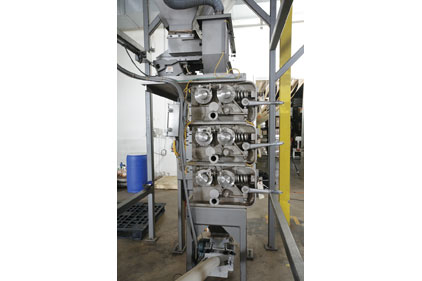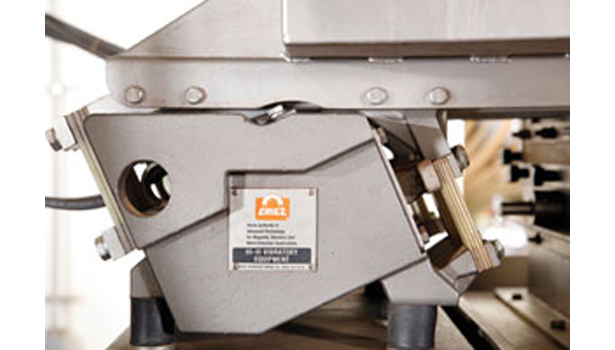Dry Processing
Grinding out higher yields of tea and coffee flavorings
Focus on: powder and bulk operatons

|
| The MPE Gran-U-Lizer granulizes spices and seasonings more uniformly and consistently than a hammer mill. Source: Eriez. |
Tea and coffee lovers worldwide are going beyond traditional brews and purchasing more of their favorite drinks with added spices, making flavored tea and coffee a multi-billion dollar industry with a healthy growth potential. Van De Vries Spice Corporation, East Brunswick, NJ, a leading importer, processor and supplier of seasonings and spices, has witnessed this growth firsthand and offers an extensive line of finely granulized tea and coffee flavorings.
A broad range of ingredients is used including cassia, the thick outer bark from which cinnamon is produced; star anise, a tough-skinned, star-shaped fruit from an oriental tree; whole, bulbous roots of ginger from the underground stem of the ginger plant; and cloves among others, according to John Blackman, director of strategic planning at Van De Vries. The raw ingredients are shipped to Van De Vries in a variety of sizes, shapes and textures before they go through the granulizing process where they are ground down to a uniform particle size. Then the flavorings are sold to customers that blend the flavorings into their tea bags and coffee products.
Transforming the ingredients into usable product takes equipment that properly feeds the different raw material and reduces it to a precise particle size. However, according to Blackman, Van De Vries was experiencing drastically lower margins on its flavored tea and coffee products because of low yield using a hammer mill.
“We were getting yields in the neighborhood of 40 percent using the hammer mill. It did not have the capability to produce a uniform particle size when it was fed with the different shapes and textures of the raw ingredients. That meant we had to purchase more raw materials to satisfy our product demand,” explains Blackman.
Van De Vries has tight specifications on particle size to get the highest yield out of each ingredient. A very fine powder is unwanted because the particles will leach through the tea bag and work their way into the tea. If the flavoring particles are too coarse, the company uses too much inventory. Van De Vries needed a piece of equipment that would improve yields

|
| The Eriez Model 48A vibratory feeder handles raw spices in a wide range of shapes, sizes and textures, eliminating the need to design a feeder for each kind of ingredient. Source: Eriez. |
and deliver a more uniform product.
The processor turned to Modern Processing Equipment, a manufacturer of precision particle size reduction equipment. Van De Vries installed an MPE 800 Gran-U-Lizer. Usually the unit ships with a standard rotary feeder, which is used for ingredients that are the same size and texture.
However, Scott Will, director of sales and marketing at MPE, realized the ingredients used by Van De Vries were so varied that a vibratory feeder from Eriez became a necessity. The MPE 800 Gran-U-Lizer was custom fitted with an Eriez Model 48A vibratory feeder drive.
“It was important for the vibratory feeder to be capable of handling all the sizes and shapes of ingredients Van De Vries grinds,” says Will. “If it weren’t for the Eriez product, we would have had to design different feeders for each kind of ingredient, and Van De Vries would have been forced to contend with the related time spent installing each feeder and performing switchovers when changing ingredients,” says Will.
According to Will, roller mill technology is more efficient than a hammer mill, which grinds by impact at high speeds and relies on a perforated sizing screen to control particle size. Roller mills typically create 50-75 percent less dust and improve desired particle uniformity by 50-100 percent, he says.
Uniform feed is essential to preventing segregation and “backup/jam” at the entry point of the grinder due to the varying sizes and shapes of product. The Eriez vibratory feeder is integral to the precise operation of the MPE Gran-U-Lizer. To provide a constant feed rate, the feeder is positioned directly above the gap between the two top rollers of the mill and maintains a falling curtain of material into the gap.
The feed rate is controlled from full capacity to a dribble feed by hand-turning a potentiometer or using an automatic control device. As the material falls between the roller sections, it is crushed into progressively smaller, uniform, ground particles that are gravity discharged from the bottom of the mill.
Since installing the MPE 800 Gran-U-Lizer with the vibratory feeder, Van De Vries has increased its yield from 40 percent to 70-80 percent and achieves product uniformity levels not possible with the hammer mill. “We have the advantage of a feeder from Eriez that handles a large range of product and the Gran-U-Lizer that gives us a uniform particle size. The result is significantly higher yields with less product going to waste,” Blackman says.
For more information:
Dave Heubel; 888-300-3743; eriez@eriez.com
Scott Will; 773-254-3929; solution@mpechicago.com
Looking for a reprint of this article?
From high-res PDFs to custom plaques, order your copy today!






